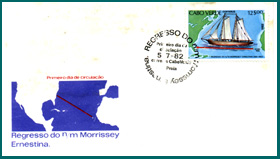 On
January 17, 1982 the Sixth Annual Friends of the Schooner
Ernestina meeting was held at the Opportunities
Industrialization Center in Providence, RI. About 25
members of the Ernestina chapters from New
England, New York, New Jersey and Washington attended. An
exhibit of photographs lined the walls of the Rhode
Island Heritage Society meeting room where the conference
was held. On
January 17, 1982 the Sixth Annual Friends of the Schooner
Ernestina meeting was held at the Opportunities
Industrialization Center in Providence, RI. About 25
members of the Ernestina chapters from New
England, New York, New Jersey and Washington attended. An
exhibit of photographs lined the walls of the Rhode
Island Heritage Society meeting room where the conference
was held.Tom Lopes, CVN publisher, asked the committee
whether the voyage of the Ernestina/Morrissey
would be under her own power or will it be towed. The
response was the vessel would sail on its own. Lopes then
informed the committee and others present that the CVN
cable production crew from the program "Boa
Vista" is planning on going to Cape Verde to video
tape officials, craftsmen and others involved in
rebuilding the ship. Oling Monteiro Jackson, coordinator
of the meeting was pleased with the turnout and called
for continued support.
"The Ernestina is not just a ship, not
just an old wooden ship," said Laura Pires
Houston, chairperson of the National Friends of the
Ernestina/Morrissey Committee. "It also
represents an indomitable, rugged spirit, that has
crossed thousands of miles, crossing and mixing
geographical, cultural and ethnic boundaries."
Among those taking part in the program were Michael L.
Platzer, technical coordinator for the Ernestina
refinishing, Oling Jackson, vice chairman of the National
Friends of Ernestina/Morrissey, Joli Gonsalves, a state
commission member, Ben Barros, chairman of the Friends of
Ernestina/Morrissey in New Bedford, Alfred Cardoza,
chairman of the Friends of Ernestina/Morrissey in Wareham
and former state representative Thomas D. Lopes.
Capt. Richard Forsey of Global Services, in Clinton,
CT, coordinated voyage preparations. Capt. Forsey is a
descendant of Capt. Bob Bartlett of the famous Arctic
expeditions of the Effie M. Morrissey.
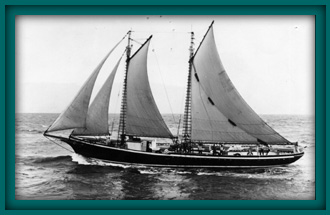 Six
American crewmembers journeyed to Cape Verde to
participate in the voyage to America. They joined seven
Cape Verdean crewmembers and Cape Verdean Capt. Marcos
Nascimento Lopes to sail the vessel to the United States. Six
American crewmembers journeyed to Cape Verde to
participate in the voyage to America. They joined seven
Cape Verdean crewmembers and Cape Verdean Capt. Marcos
Nascimento Lopes to sail the vessel to the United States.
The American crew members included Norman Gomes, a former
merchant seaman now working at Peregrine Yachts; Margaret
Lyons of New York City, owner of a printing and design
company and an experienced sailor; Ted Miles of Long
Island, a volunteer research assistant for several museum vessels (now
out at the San Francisco Maritime NHP); Stephen Platzer, a senior research scientist for
the American Hoechst and ship's radio officer from New Brunswick, New Jersey;
Stephen Hopkins, an expert on schooner restoration; and
Steven Brown, ship's medic, on leave as Mayor of Carthage, Maine.
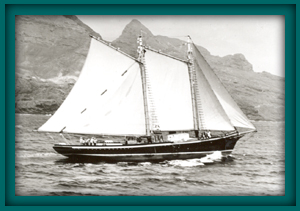 Prior to departure, days were spent scraping and painting surfaces,
securing safety equipment, installing a generator and pump, and
preparing and loading ballast to stabilize the ship and prevent
capsizing in strong winds. For ballast the crew used sand as a cheap
and efficient alternative to cargo. They went to a nearby beach and
dug up, bagged, tied off and loaded 40 tons of sand into the cargo
hold. Another three tons of pig iron completed the weight needed by
the 106-foot ship. Prior to departure, days were spent scraping and painting surfaces,
securing safety equipment, installing a generator and pump, and
preparing and loading ballast to stabilize the ship and prevent
capsizing in strong winds. For ballast the crew used sand as a cheap
and efficient alternative to cargo. They went to a nearby beach and
dug up, bagged, tied off and loaded 40 tons of sand into the cargo
hold. Another three tons of pig iron completed the weight needed by
the 106-foot ship.
The Ernestina left Mindelo, Cape Verde, at 10:30 am
July 15, 1982.
The oldest crew member was 70-year-old Eugenio Fortes, who had
called Ernestina home since 1956. He was an energetic, wiry man with
strong ideas about the way things should be done. Another crewmember,
67-year-old Antonio, sailmaker, would sit for hours on deck, repairing
the weathered or damaged sails or creating new sails with his tough,
nimble fingers.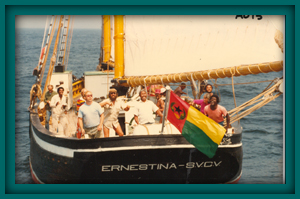
Gingi was cook and would spend 14 hours a day preparing meals. The
ship carried 60 days worth of provisions, including 30 live chickens
and four live pigs, which were slaughtered as needed and then packed
in salt for preservation. There was no refrigeration nor running
water. Both lunch and dinner began with soup, followed by pork,
chicken or freshly caught fish; potatoes, rice or spaghetti;
occasional onions or beans. Wine water and Tang were available for
drinks. Gingi often baked bread, served directly from the oven.
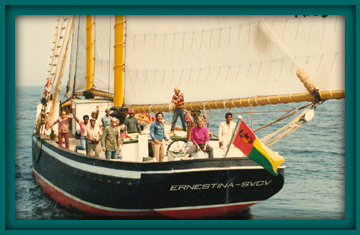 Stephan Platzer was not assigned to a watch because of his
responsibilities as radio operator. Every day at 3 pm EST he made
contact with ham operators in Cape Verde and the United States who had
generously offered their services as contact points. The United
Nations Amateur Radio Club has loaned the ship a single sideband
transceiver for the crossing. The radio antenna, strung between the
fore and main masts each day could not remain aloft because it would
conflict with the foresail rigging. Stephan would climb aloft twice a
day to rig and derig the antenna. Stephan Platzer was not assigned to a watch because of his
responsibilities as radio operator. Every day at 3 pm EST he made
contact with ham operators in Cape Verde and the United States who had
generously offered their services as contact points. The United
Nations Amateur Radio Club has loaned the ship a single sideband
transceiver for the crossing. The radio antenna, strung between the
fore and main masts each day could not remain aloft because it would
conflict with the foresail rigging. Stephan would climb aloft twice a
day to rig and derig the antenna.
The daily broadcasts were a lifeline for the crew as the voyage
progressed. The ham operators provided weather reports, relayed
reassuring messages to waiting families and kept Stephan in touch with
his brother, Michael, who was coordinating plans for the arrival
celebration. The radio brought them close to people whom they had
never met. One ham operator was Art Greenberg, a Long Island resident
who never missed a broadcast.
At 8:30 pm August 24, 1982 Schooner Ernestina docked
at Ft. Adams in Newport, RI after a 38 day passage from
Mindelo, Sao Vicente, CVI. [Passage description drawn from Return of
the Ernestina by Linda Cardillo, Rutgers Alumni Magazine,
Winter 1983.]
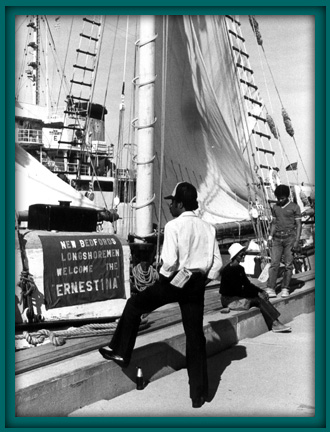 Mr. Humberto Morais, Director General of Ports in Cabo
Verde and Mr. Orlando Lima, coordinator for the Ernestina
Project in Cabo Verde, arrived in the United States from
Cabo Verde and for the welcoming ceremony in Newport, RI. Mr. Humberto Morais, Director General of Ports in Cabo
Verde and Mr. Orlando Lima, coordinator for the Ernestina
Project in Cabo Verde, arrived in the United States from
Cabo Verde and for the welcoming ceremony in Newport, RI.
An article appeared in the New Bedford Standard-Times
Monday, August 30, 1982:
Ernestina repatriated
in emotional ceremony, by David H. Kogut
New Bedford, MA- Slowly, very slowly yesterday,
Eugenio Lopes of Mindelo, Cape Verde, lowered the
flag of his native land from its flag staff on the
stern of the schooner Ernestina. He had lived on the
ship for 18 years as a crewman and caretaker, and
made the recent voyage from the Cape Verde Islands.
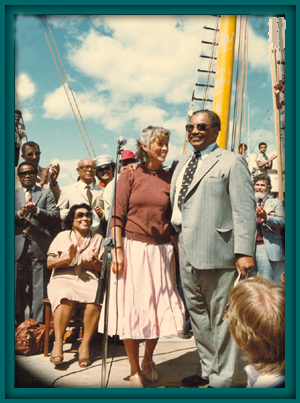 A moment later, at 3pm, crew member Peggy Lyons
of New York- the sole woman on the 38-day voyage to
New England- hoisted the Stars and Stripes. The
Ernestina had become American again. [She is shown in image to the
right standing with Joli Gonsalves, Ernestina Commission chair] A moment later, at 3pm, crew member Peggy Lyons
of New York- the sole woman on the 38-day voyage to
New England- hoisted the Stars and Stripes. The
Ernestina had become American again. [She is shown in image to the
right standing with Joli Gonsalves, Ernestina Commission chair]
The two-hour transfer ceremony was held on New
Bedford’s Steamship Authority pier yesterday,
marking the donation of the 88-year-old windjammer
from the Republic of Cape Verde to the people of the
United States and, finally, to the Massachusetts
Schooner Ernestina Commission. New Bedford will be
the Ernestina’s homeport - a theme stressed
repeatedly during a ceremony that drew on every level
of human experience, from high-level diplomacy to the
yearnings of the humblest immigrant.
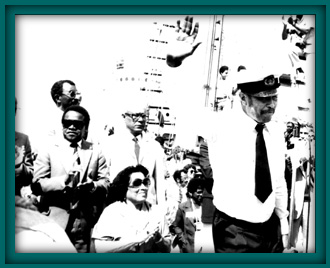 Officially, the ship was given to America by
Jose Luis Fernandes Lopes, the Cape Verdean
Republic’s ambassador to the United States. The
arrival of the 107-foot ship in New Bedford "is
more than a tribute to those Cape Verdeans who became
the pioneers of our emigration...who demonstrated the
utmost courage and perseverance by leaving their
beloved country in search of a new life in distant
lands," he said. The ship is "an
unmistakable catalyst in fostering a very special
bond of friendship and human assistance from one
country to another." Officially, the ship was given to America by
Jose Luis Fernandes Lopes, the Cape Verdean
Republic’s ambassador to the United States. The
arrival of the 107-foot ship in New Bedford "is
more than a tribute to those Cape Verdeans who became
the pioneers of our emigration...who demonstrated the
utmost courage and perseverance by leaving their
beloved country in search of a new life in distant
lands," he said. The ship is "an
unmistakable catalyst in fostering a very special
bond of friendship and human assistance from one
country to another."
Lopes closed with a wish, that the tall ship
riding placidly at pier side "forever sail on
the winds of hope, ever to remind us of the boundless
possibilities of human understanding and
cooperation."
His wishes were accepted with a hug from
Raymond Pardon, the U.S. State Department’s
specialist on Cape Verdean affairs. Pardon quoted
from the text of a federal message to Cape Verdean
President Aristides Pereira, thanking him for the
gift. Signed, "Sincerely, Ronald Reagan,"
the letter read:
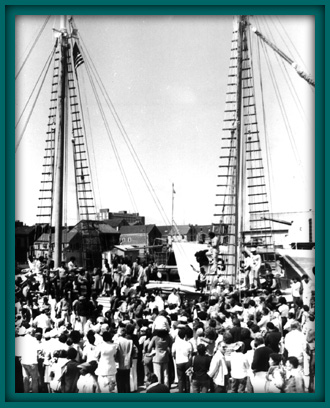 "The gift of the schooner Ernestina
restored so carefully by your government and the
ship’s many friends, is deeply appreciated. Its
presence in New England will be a reminder of the
seafaring traditions and special ties that our
peoples share." "The gift of the schooner Ernestina
restored so carefully by your government and the
ship’s many friends, is deeply appreciated. Its
presence in New England will be a reminder of the
seafaring traditions and special ties that our
peoples share."
"On behalf of my fellow Americans, to whom
you have so thoughtfully given the Ernestina, let me
thank you for an enduring symbol of private endeavor
and of effective cooperation between our governments.
As you thoughtfully suggest, let it also be an
example for larger cooperation and understanding
among the peoples of the world."
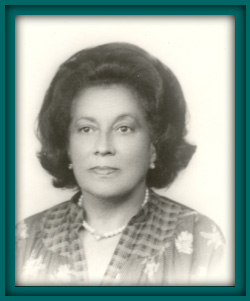 Ernestina Mendes Randall, 65, and namesake of
the schooner, was at yesterday’s ceremony,
unable to say anything more than "Thank you,
America," before surrendering to the tears
cascading down her cheeks. Ernestina Mendes Randall, 65, and namesake of
the schooner, was at yesterday’s ceremony,
unable to say anything more than "Thank you,
America," before surrendering to the tears
cascading down her cheeks.
For most of the crowd of 1,000, the revels had
started Saturday night, when the ship arrived at the
Steamship Authority pier to a New Year’s
Eve-style celebration of horns, cheers, bells and
chants. The ship had docked in Newport six days ago,
at the conclusion of a trans-Atlantic crossing made
entirely under sail.
Antone Ramos of Providence, first national
chairman of the Friends of the Ernestina, cautioned
yesterday that much work lies ahead. "We are
going to keep the Ernestina in New Bedford."
Ramos said. The ship has more than Cape Verdean
history Laura Pires Houston said. "It has human
history, universal history," a message that is
"trans-national, trans-ethnic." The history
of the ship has traversed more than 80 years. It is
broader than just one people. "What it can tell
us about is the possibility of what people can do
together." Mrs. Houston said.
The Ernestina’s homeport has been New
Bedford since its festive arrival three months ago
after a 38-day sail from Cape Verde. But finances
have been and still are a problem.
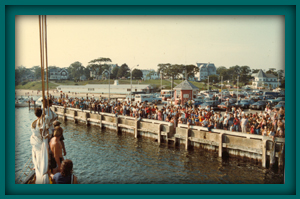
The crowd waits
for Ernestina to come alongside at Onset Town Pier enroute to
Gloucester to be laid up for the winter and await work.
|